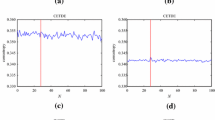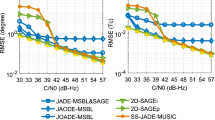Abstract
Multipath delay estimation plays an important role in wireless channel estimation, equalization, and synchronization. Weighted Fourier transform and relaxation (WRELAX) algorithm is frequently used for its high resolution and good convergence property. However, the WRELAX algorithm is prone to false estimated delays and irregular multipath sorting under Nakagami-based multipath channel, which is a more practical model than the traditional Rice or Rayleigh-based multipath model, because of the oscillatory cost function property between the received and the known transmitted signals. Given relatively stable characteristics and delay power spectrum distribution characteristics of the wireless channel, together with the principle that the statistical probability of the true estimated delays is larger than that of the false ones through statistical detection, this study proposes a delay power spectrum characteristic-based statistical WRELAX time delay estimation algorithm. The improved algorithm excludes false estimated paths and sorts the delays in size order simultaneously by establishing a two-dimensional relation graph composed of the superposition value of estimated attenuation coefficient and their response-estimated delays. Simulation under three typical Nakagami-based slow fading multipath channels shows that the proposed algorithm has good accuracy and robustness, and the cost of complexity increased by only a few times.





Similar content being viewed by others
References
Pätzold, M. (2012). Mobile radio channels (2nd ed.). Chichester: Wiley.
Filho, J. C. S. S., & Yacoub, M. D. (2009). On the simulation and correlation properties of phase-envelope Nakagami fading processes. IEEE Transactions on Communications, 57(4), 906–909. doi:10.1109/TCOMM.2009.04.070195.
Qu, B., Wei, J., Tang, Z., Yan, T., & Zhou, Z. (2014). Analysis of combined effects of multipath and CW interference on coherent delay lock loop. Wireless Personal Communications, 77(3), 2213–2233. doi:10.1007/s11277-014-1634-1.
Shang, F., Champagne, B., & Psaromiligkos, I. (2013). Time of arrival and power delay profile estimation for IR-UWB systems. Signal Processing, 93(5), 1317–1327. doi:10.1016/j.sigpro.2012.11.006.
Verteletskaya, E., Sakhnov, K., & ŠIMÁK, B. (2012). Delay estimator and improved proportionate multi-delay adaptive filtering algorithm. Radioengineering, 21(1), 182–189.
Trivedi, A., & Gupta, R. (2010). Improved ML channel estimation for uplink MC-CDMA systems in closely spaced multipath channels. Wireless Personal Communications, 52(2), 341–357. doi:10.1007/s11277-008-9651-6.
Xie, S., Hu, A., & Huang, Y. (2012). Time-delay estimation in the multi-path channel based on maximum likelihood criterion. KSII Transactions on Internet and Information Systems, 6(4), 1063–1075.
Bhardwaj, T. P., & Nath, R. (2010). Maximum likelihood estimation of time delays in multipath acoustic channel. Signal Processing, 90(5), 1750–1754. doi:10.1016/j.sigpro.2009.11.023.
Li, W., & Preisig, J. C. (2007). Estimation of rapidly time-varying sparse channels. IEEE Journal of Oceanic Engineering, 32(4), 927–939. doi:10.1109/joe.2007.906409.
Min, Y., Ping, W., Xian-Ci, X., & Heng-Ming, T. (2003). Efficient EM initialisation method for time delay estimation. Electronics Letters, 39(12), 935–936. doi:10.1049/el:20030624.
Oziewicz, M. (2005). On application of MUSIC algorithm to time delay estimation in OFDM channels. IEEE Transactions on Broadcasting, 51(2), 249–255. doi:10.1109/tbc.2005.846193.
Feng-Xiang, G., Dongxu, S., Yingning, P., & Li, V. O. K. (2007). Super-resolution time delay estimation in multipath environments. IEEE Transactions on Circuits and Systems I: Regular Papers, 54(9), 1977–1986. doi:10.1109/tcsi.2007.904693.
Jian, L., Renbiao, W., & Zheng-She, L. (1998). Efficient super resolution time delay estimation techniques. In Proceedings of the 1998 IEEE international conference on acoustics, speech and signal processing, 12–15 May 1998 (vol. 4, pp. 2473–2476, vol. 2474 ). doi:10.1109/icassp.1998.681652
Jian, L., & Renbiao, W. (1998). An efficient algorithm for time delay estimation. IEEE Transactions on Signal Processing, 46(8), 2231–2235. doi:10.1109/78.705444.
Yacoub, M. D. (2010). Nakagami-m phase-envelope joint distribution: A new model. IEEE Transactions on Vehicular Technology, 59(3), 1552–1557. doi:10.1109/TVT.2010.2040641.
Yacoub, M. D. (2009). Nakagami-m phase-envelope joint distribution: An improved model. In Microwave and optoelectronics conference (IMOC), 2009 SBMO/IEEE MTT-S International, 3–6 Nov. 2009 (pp. 335–339). doi:10.1109/IMOC.2009.5427569
Ming, Z. (2011). Frequency correlated MIMO channel modeling and simulation research. Nanjing: Nanjing University of Aeronautics and Astronautics.
Matthaiou, M., & Laurenson, D. I. (2007). Rejection method for generating Nakagami-m independent deviate. Electronics Letters, 43(25), 1474–1475.
Lei, S., Zhen, G., Liu, Y., & Li, X. (2014). A novel simulation method for Nakagami-m fading channel. Paper presented at the 31st general assembly of the International Union of Radio Science, Beijing.
Lei, S., Zhen, G., Yanming, L., Lei, Z., & Xiaoping, L. (2014). A complex Nakagami fading channel modeling method. China: Beijing KEYI Intellectual Property Agency.
Manickam, T. G., Vaccaro, R. J., & Tufts, D. W. (1994). A least-squares algorithm for multipath time-delay estimation. IEEE Transactions on Signal Processing, 42(11), 3229–3233. doi:10.1109/78.330381.
Moghaddam, P. P., Amindavar, H., & Kirlin, R. L. (2003). A new time-delay estimation in multipath. IEEE Transactions on Signal Processing, 51(5), 1129–1142. doi:10.1109/TSP.2003.810290.
Renbiao, W., & Jian, L. (1998). Time-delay estimation via optimizing highly oscillatory cost functions. IEEE Journal of Oceanic Engineering, 23(3), 235–244. doi:10.1109/48.701196.
Zhou, X., Zhang, H., Hu, X., Hui, J., & Li, T. (2014). Improved results on robust stability for systems with interval time-varying delays and nonlinear perturbations. Mathematical Problems in Engineering, 2014, 7. doi:10.1155/2014/898260.
Ermolaev, V. T., Mal’tsev, A. A., & Rodyushkin, K. V. (2001). Statistical Characteristics of the AIC and MDL criteria in the problem of estimating the number of sources of multivariate signals in the case of a short sample. Radiophysics and Quantum Electronics, 44(12), 977–983. doi:10.1023/A:1014882129741.
Failli, M. (1989). Digital land mobile radio communications. COST 207: EC.
3GPP TS 05.05 V8.20.0. (2005–2011). 3rd Generation Partnership Project; technical specification group GSM/EDGE radio access (TM) network; radio transmission and reception (2005). V8.20.0, Valbonne, France.
Acknowledgments
This work is supported by the National Program on Key Basic Research (Project No. 2014CB340200) and the National Natural Science Foundation of China (No. 61301173). We are grateful to Prof. Li Xiaoping and Prof. Liu Yanming for their assistance in conducting this study.
Author information
Authors and Affiliations
Corresponding author
Rights and permissions
About this article
Cite this article
Shi, L., Zhao, L., Qiao, Z. et al. A New Statistical WRELAX Algorithm Under Nakagami Multipath Channel Based on Delay Power Spectrum Characteristic. Wireless Pers Commun 82, 1483–1495 (2015). https://doi.org/10.1007/s11277-015-2294-5
Published:
Issue Date:
DOI: https://doi.org/10.1007/s11277-015-2294-5




